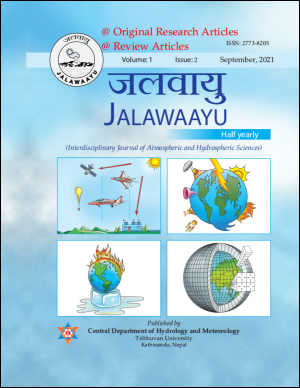Prediction of Thunderstorms based on Atmospheric Instability Indices over Bangladesh using WRF-ARW Model
DOI:
https://doi.org/10.3126/jalawaayu.v1i2.41008Keywords:
Thunderstorm, Instability Indices, Forecasting, Predictability, MCAPEAbstract
In this study an attempt has been made to inspect the forecasting of thunderstorms based on two cases (1st case: 17th May, 2019 and 2nd case: 31st March, 2019) over Dhaka using WRF Model. The model is run for 72 hours with 03 nested domain of 09 km, 03 km and 01 km horizontal resolutions using 0.25º X 0.25º six hourly global data assimilation system. For model simulation, Milbrandt-Yau Double-Moment 7-class scheme (9) has been used as microphysics scheme in this study. The model performance is evaluated by calculating hourly instability indices (VTI, TTI, KI, CTI, MCAPE, MCIN, BRN, LI, SI, SWI) value and have been compared with the threshold value of indices. Different meteorological parameters such as MSLP, temperature, winds at upper (300 hPa) and lower (925 hPa) level, relative humidity along with vertical cross section are also studied by the model and compared with the favorable conditions for forming of thunderstorms. Area rage rainfall (hourly) value has been also calculated and compared with indices value to comprehend the nature of thunderstorms. Observing the indices value it is seen that all indices value increase sharply 5-6 hours before of thunderstorm occurring and MCAPE is giving more reliable result. Moreover, this study shows that inner two domains (3 and 1 km resolution) are giving better results than outer one and which indices are more probable in forecasting of thunderstorm for our country as well as giving less Root Mean square Error. From the simulated and validated results, it can be concluded that the model performance of instability indices can be used as forecasting of thunderstorms over Bangladesh.
Downloads
Downloads
Published
How to Cite
Issue
Section
License

This work is licensed under a Creative Commons Attribution 4.0 International License.
Copyright © of the articles is held by the authors.

